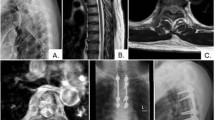Abstract
Purpose
We performed a retrospective analysis of all cases of lumbo-sacral or sacral metastases presenting with compression of the cauda equina who underwent urgent surgery at our institution. Our objective was to report our experience on the clinical presentation, management and finally the surgical outcome of this cohort of patients.
Methods
We reviewed medical notes and images of all patients with compression of the cauda equina as a result of lumbo-sacral or sacral metastases during the study period (2004–2011). The collected clinical data consisted of time of onset of symptoms, neurology (Frankel grade), ambulatory status and continence. Operative data analysed were details of surgical procedure and complications. Post-operatively, we reviewed neurological outcome, ambulation, continence, destination of discharge and survival.
Results
During the 8-year study period, 20 patients [11 males, 9 females; mean age 61.8 years (29–87)] had received urgent surgery for metastatic spinal cauda compression caused by lumbo-sacral or sacral metastases. The majority of patients presented with symptoms of pain and neurological deterioration (n = 14) with onset of pain considerably longer than neurology symptoms [197 days (3–1,825) vs. 46 days (1–540)]; all patients were Frankel C (n = 2, both non-ambulatory), D (n = 13) or E (n = 5) at presentation and three patients were incontinent of urine. Operative procedures performed were posterior decompression with (out) fusion (n = 12), posterior decompression with sacroplasty (n = 1), decompression with lumbo-pelvic stabilisation with (out) kyphoplasty/sacroplasty (n = 7) and posterior decompression/reconstruction with anterior corpectomy/stabilisation (n = 2). Post-operatively, 5/20 (20 %) patients improved one Frankel grade, 1/20 (5 %) improved two grades, 13/20 (65 %) remained stable (8 D, 5 E) and 1/20 (5 %) deteriorated. All patients were ambulatory and 19/20 were continent on discharge. The mean length of stay was 7 days (4–22). There were 6/20 (30 %) complications: three major (PE, deep wound infection, implant failure) and three minor (superficial wound infection, incidental durotomy, chest infection). All patients returned back to their own home (n = 14/20, 70 %) or a nursing home (n = 6/20, 35 %). Thirteen patients are deceased (mean survival 367 days (120–603) and seven are still alive [mean survival 719 days (160–1,719)].
Conclusion
Surgical intervention for MSCC involving the lumbo-sacral junction or sacral spine has a high but acceptable complication rate (6/20, 30 %), and can be important in restoring/preserving neurological function, assisting with ambulatory function and allowing patients to return to their previous residence.

Similar content being viewed by others
References
Kollender Y, Meller I, Bickets J et al (2003) Role of adjuvant cryosurgery in intralesional treatment of sacral tumors. Cancer 97:2830–2838
Cummings BJ, Hobson DI, Bush RS (1983) Chordoma: the results of megavoltage radiation therapy. Int J Radiat Oncol Biol Phys 9:633–642
Raque GH Jr, Vitaz TW, Shields CB (2001) Treatment of neoplastic diseases of the sacrum. J Surg Oncol 76:301–307
Wuisman P, Lieshout O, Sugihara S, Van Dijk M (2000) Total sacrectomy and reconstruction: oncologic and functional outcome. Clin Orthop 381:192–203
Llauger J, Palmer J, Amores S, Bague S, Camins A (2000) Primary tumors of the Sacrum :diagnostic imaging. Am Roentgenol 174:417–424
Quraishi NA, Gokaslan ZL, Boriani S (2010) The surgical management of metastatic epidural compression of the spinal cord. J Bone Joint Surg Br 92(8):1054–1060
Quraishi NA, Esler C (2011) Metastatic spinal cord compression. British Med J 342:d2402
Quraishi NA, Giannoulis KE, Edwards KL, Boszczyk BM (2012) Management of metastatic sacral tumours. Eur Spine J 21(10):1984–1993
King GJ, Kostuik JP, McBroom RJ, Richardson W (1991) Surgical management of metastatic renal carcinoma of the spine. Spine 16:265–271
Sundaresan N, Choi IS, Hughes JEO, Sachdev VP, Berenstein A (1990) Treatment of spinal metastases from kidney cancer by presurgical embolization and resection. J Neurosurg 73(4):548–554
Berkefeld J, Scale D, Kirchner J, Heinrich T, Kollath J (1999) Hypervascular spinal tumors: influence of the embolization technique on perioperative hemorrhage. AJNR 20(5):757–763
Feiz-Erfan I, Fox BD, Nader R, Suki D, Chakrabarti I, Mendel E, Gokaslan ZL, Rao G, Rhines LD (2012) Surgical treatment of sacral metastases: indications and results. J Neurosurg Spine 17(4):285–291
Hingibotham NL, Philips RF, Farr HW et al (1967) Chordoma thirty-five year study at Memorial Hospital. Cancer 20:1841–1850
Kollender Y, Bickets J, Price WM et al (2000) Metastatic renal cell carcinoma of bone: indications and technique of surgical intervention. J Urol 164:1505–1508
Gibbs IC, Chang SD (2003) Radiosurgery and Radiotherapy for Sacral Tumours. Neurosurg Focus 15(2):E8
Salehi SA, McCafferty RR, Karahalios D et al (2002) Neural function preservation and early mobilization after resection of metastatic sacral tumours and Lumbosacropelvic junction reconstruction Report of three cases. J Neurosurgery 97(Spine 1):88–93
Marshall LF, Langift TW (1997) Combined treatment for metastatic extradural tumours of the spine. Cancer 40:2067–2070
Maranzano E, Latini P (1995) Effectiveness of radiation therapy with out surgery in metastatic spinal cord compression : final results from a prospective trial. Int J Radiat Oncol Biol Phys 32:959–967
Loblaw DA, Laparriere NJ (1998) Emergency treatment of malignant extradural spinal cord compression : an evidenced based guideline. J Clin Oncol 16(4):1613–1624
Sundaresan N, Scher H, DiGiacinto GV, Yagoda A, Whitmore W, Choi IS (1986) Surgical treatment of spinal cord compression in kidney cancer. J Clin Oncol 4:1851–1856
Weigl B, Maghsudi M, Neuman C, Kretschmer R, Muller FL, Nhrlich M (1999) Surgical management of symptomatic spinal metastasis. Spine 24:2240–2246
Conflict of interest
None.
Author information
Authors and Affiliations
Corresponding author
Rights and permissions
About this article
Cite this article
Quraishi, N.A., Giannoulis, K.E., Manoharan, S.R. et al. Surgical treatment of cauda equina compression as a result of metastatic tumours of the lumbo-sacral junction and sacrum. Eur Spine J 22 (Suppl 1), 33–37 (2013). https://doi.org/10.1007/s00586-012-2615-2
Received:
Revised:
Accepted:
Published:
Issue Date:
DOI: https://doi.org/10.1007/s00586-012-2615-2




